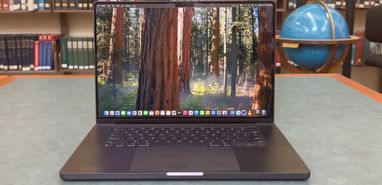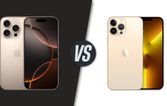
More ports, enhanced RAM, a refined display, and an upgraded webcam—all at a more accessible price point.
For years, the base model MacBook Pro felt like a compromise between the lightweight MacBook Air and the powerful MacBook Pro, carrying the Air’s processor in a Pro shell, with certain features removed to keep it firmly in the middle ground.
Last year’s 14-inch MacBook Pro marked a shift in the right direction, finally ditching the Touch Bar and bringing the model closer to the higher-end Pros. However, it still followed the same pattern: a slightly weaker processor, lower starting RAM, and one fewer port. Although a solid improvement over previous M2 and M1 models, it wasn’t quite the “Pro” experience.
With the introduction of the M4 chip, Apple has finally brought a MacBook Pro that truly feels like a complete Pro device, offering an uncompromised user experience. It’s a laptop that doesn’t leave you feeling like you’re missing out.
Apple MacBook Pro 14 (2024, M4)
Pros:
- Improved features from last year’s model
- Full I/O options from higher-end MacBook Pros
- Increased RAM as standard
- Sharper, clearer new webcam
- Nano-texture display is an excellent addition
Cons:
- Desk View webcam feature lacks quality and has some distortion
- Space black finish tends to show smudges
- Apple’s pricing structure may tempt you toward pricier upgrades like M4 Pro or Max versions
The M4 MacBook Pro addresses nearly every complaint we had with the previous model. Priced at $1,599, it includes a 10-core CPU, 10-core GPU, 16GB of memory, and a 512GB SSD—the same starting price as the M3 model but with two more CPU cores, double the RAM, and an extra Thunderbolt port. Positioned on the right side, this port finally allows charging or connecting an external display from either side, much like higher-end Pro models. Additionally, Apple has increased the standard memory across all configurations to 16GB.
Beyond these already significant upgrades, Apple has added a 12-megapixel webcam with Center Stage and Desk View features, an optional nano-texture anti-glare display for $150, and a stylish space black chassis. Furthermore, the M4 Pro now supports dual external displays, with its lid open—one more than the M3 model allowed.
Enhanced Performance for Creative Tasks
These upgrades make the M4 MacBook Pro a worthwhile upgrade over the MacBook Air for those who regularly work with creative applications like Final Cut Pro or Premiere Pro. Having edited high-resolution raw photos on an M1 MacBook Air for work, I know firsthand how capable these machines are. However, the limitations of port selection and performance with a passively cooled processor are noticeable. This is why I use a Mac Mini with an M2 Pro personally, which has offered excellent value.
While editing photos on the M4 MacBook Pro, I was pleasantly surprised by its speed, especially when displaying and processing full-res 33-megapixel raws. Even with my usual Lightroom catalog and images stored on an external SSD, it handled the workload impressively and stayed quiet and cool. During moderate-to-heavy use, the laptop lasted over 12 hours without being plugged in, making it highly reliable for all-day productivity.
The nano-texture display also proved beneficial, eliminating glare and improving flexibility for working in diverse lighting conditions. The slight contrast difference compared to glossy screens is well worth the convenience, particularly for visual professionals.
Performance Improvements and Benchmarks
While not as powerful as the M4 Pro or M4 Max in the most demanding tasks, the standard M4 has made significant strides over the M3. The M4 scored around 64% better than the M3 in Cinebench’s multicore test and maintained a 41% advantage in a sustained 30-minute benchmark loop. The M4’s two additional cores over the M3 give it an edge, but single-core scores in both Cinebench and Geekbench also showed more than a 20% improvement. GPU benchmarks reflected up to 25% faster performance despite having the same number of GPU cores.
Benchmark Comparison for Apple MacBook Pro M4 Series
| System | MacBook Pro 14″ M4/10C/10C/16GB/1TB | MacBook Pro 14″ M3 8C/10C/16GB/1TB | MacBook Pro 16″ M3 Max 16C/40C/128GB/8TB | MacBook Pro 16″ M2 Max 12C/38C/32GB/1TB |
|---|---|---|---|---|
| Premiere Pro 4K Export | 3 mins 14 secs | 3 mins 47 secs | 1 min 30 secs | 1 min 39 secs |
| Cinebench 2024 Multi | 1003 | 612 | 1684 | 1036 |
| Cinebench 2024 Single | 172 | 141 | 142 | 121 |
| Cinebench 2024 GPU | 3988 | 3334 | 12977 | 5927 |
| Cinebench 2024 Multi 30-min loop | 1010 | 717 | 1666 | 1024 |
| Geekbench 6 CPU Single | 3826 | 3176 | 3188 | 2787 |
| Geekbench 6 CPU Multi | 14990 | 12078 | 21277 | 14833 |
| Geekbench 6 GPU (OpenCL) | 38098 | 30426 | 91480 | 87247 |
| Geekbench 6 GPU (Metal) | 58059 | 47509 | 156095 | 138285 |
| Shadow of the Tomb Raider | 38fps | 32fps | 120fps | 104fps |
Webcam, Display Options, and Pricing
While Apple has had issues with webcam quality in the past, the new 12MP camera in the M4 MacBook Pro offers excellent contrast, even in challenging lighting. The Center Stage software does a decent job of keeping the user in frame without excessive reframing. However, the Desk View feature, which creates a top-down view of the desk, still falls short in quality due to heavy cropping and low resolution.
Priced at $1,599, the M4 MacBook Pro is just $100 more than the 15-inch MacBook Air with comparable specs. The additional cost provides users with significantly improved performance, more Thunderbolt ports, a high-resolution screen with up to 120Hz refresh rate, two extra speakers, and a superior webcam. For many, these upgrades justify the extra investment.
Opting for additional features, like the anti-glare screen and increased storage, can push the price up to $1,949. At this price point, it’s only $50 away from the M4 Pro configuration, which offers faster storage, extra cores, more RAM, and Thunderbolt 5 ports. Apple’s pricing structure makes it tempting to keep upgrading until reaching the next model.
Despite the temptations, the base model M4 MacBook Pro finally feels like a complete Pro option. With sufficient memory and storage, all the ports, and high-end features available in the pricier models, it’s a practical choice for professionals seeking quality and value.








By Andrej Kovacevic
Updated on 9th March 2025